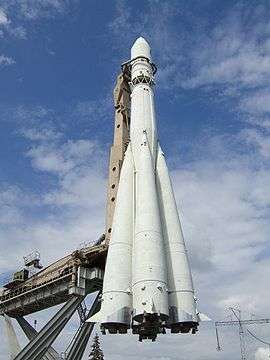Vostok (rocket family)
 Vostok 8K72K rocket on display in Moscow at the All Russia Exhibition Centre | |
| Function | Carrier rocket |
|---|---|
| Manufacturer | RKK Energia |
| Country of origin | Soviet Union |
| Size | |
| Mass | 280,000–290,000 kg (620,000–640,000 lb) |
| Stages | 3 |
| Capacity | |
| Payload to LEO | 4,725 kilograms (10,417 lb) |
| Associated rockets | |
| Family | R-7 |
| Comparable |
Atlas Titan |
| Launch history | |
| Status | Retired |
| Launch sites |
Baikonur: LC-1/5, 31/6 Plesetsk: LC-41/1, 43/3, 43/4 |
| Total launches |
Vostok-L: 4 Vostok-K: 13 Vostok-2: 45 Vostok-2M: 94 Soyuz/Vostok: 2 |
| Successes |
Vostok-L: 3 Vostok-K: 11 Vostok-2: 40 Vostok-2M: 92 Soyuz/Vostok: 2 |
| Failures |
Vostok-L: 1 Vostok-K: 2 Vostok-2: 5 Vostok-2M: 2 |
| First flight | 15 May 1960 (Vostok-L) |
| Last flight | 29 August 1991 (Vostok-2M) |
| Notable payloads |
Vostok Zenit Meteor |
| First stage (Block B, V, G, D) | |
| Engines | 1 RD-107-8D74-1959 |
| Thrust | 970.86 kN |
| Burn time | 118 seconds |
| Fuel | Kerosene/LOX |
| Second stage (Block A) | |
| Engines | 1 RD-108-8D75-1959 |
| Thrust | 912 kN |
| Burn time | 301 seconds |
| Fuel | Kerosene/LOX |
| Third stage (Block E) | |
| Engines | 1 RD-0109 |
| Thrust | 54.5 kN |
| Burn time | 365 seconds |
| Fuel | Kerosene/LOX |
Vostok (Russian: Восток, translated as "East") was a family of rockets derived from the Soviet R-7 Semyorka ICBM and was designed for the human spaceflight programme. This family of rockets launched the first artificial satellite (Sputnik 1) and the first manned spacecraft (Vostok) in human history. It was a subset of the R-7 family of rockets.
On March 18, 1980 a Vostok-2M rocket exploded on its launch pad at Plesetsk during a fueling operation, killing 48 people. An investigation into a similar – but avoided – accident revealed that the substitution of lead-based for tin-based solder in hydrogen peroxide filters allowed the breakdown of the H2O2, thus causing the resultant explosion.
Variants
The major versions of the rocket were:
- Luna 8K72 - used to launch the early Luna spacecraft
- Vostok-L 8K72 - Variant of the Luna, used to launch prototype Vostok spacecraft
- Vostok-K 8K72K - a refined version of the above. This was the version actually used for human spaceflight
- Vostok-2 8A92 - used for launching Zenit reconnaissance satellites throughout the 1960s
- Vostok-2M 8A92M - modified version for launching Meteor weather satellites into higher orbits.
- Soyuz/Vostok 11A110 - hybrid of Soyuz and Vostok rockets used as an interim for two launches
Vostok 8K72K
- First Stage — Block B, V, G, D (four strap-on boosters)
- Second Stage — Block A (core stage)
- Gross mass: 100,400 kg
- Empty mass: 6,800 kg
- Thrust (vac): 912 kN
- Isp: 315 seconds (3.09 km/s)
- Burn time: 301 s
- Isp(sl): 248 seconds (2.43 km/s)
- Diameter: 2.99 m
- Length: 28.00 m
- Propellants: Lox/Kerosene
- Engine: 1 x RD-108-8D75-1959
- Third Stage — Block E
- Gross mass: 7,775 kg
- Empty mass: 1,440 kg
- Thrust (vac): 54.5 kN
- Isp: 326 seconds (3.20 km/s)
- Burn time: 365 s
- Diameter: 2.56 m
- Span: 2.56 m
- Length: 2.84 m
- Propellants: Lox/Kerosene
- Engine: 1 x RD-0109
Gallery
 Vostok rocket
Vostok rocket.jpg) Vostok rocket
Vostok rocket
See also
This article is issued from
Wikipedia.
The text is licensed under Creative Commons - Attribution - Sharealike.
Additional terms may apply for the media files.
